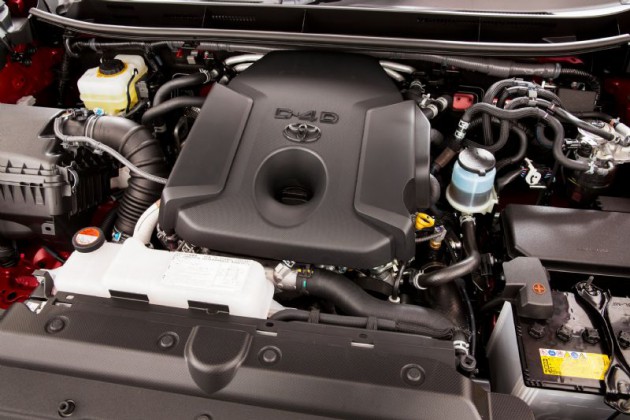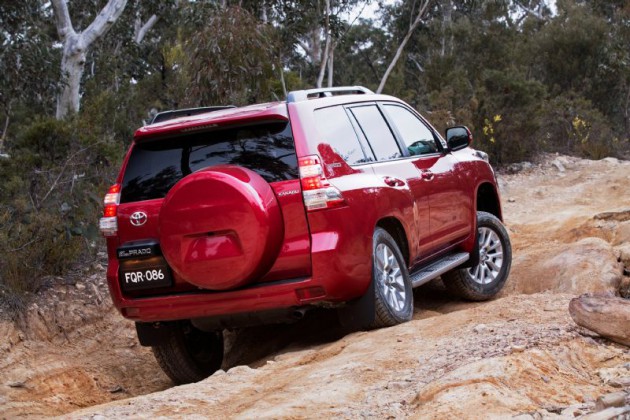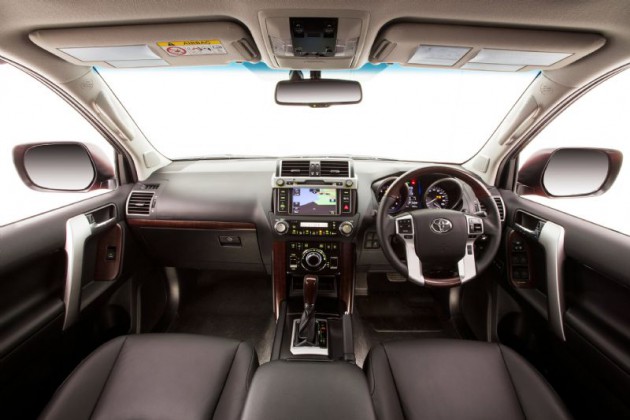Toyota has powered-up its market-leading Land Cruiser Prado with higher levels of performance and driving enjoyment by introducing a new-generation turbo-diesel engine, improved petrol V6 and new 6-speed automatic transmission.

The all-new high-torque 2.8-litre four-cylinder engine is 227cm3 smaller than the engine it replaces, yet it boosts output with up to 450Nm of torque while reducing fuel use and emissions.
Prado’s V6 petrol engine has been upgraded to produce a further 5kW of power while also lowering emissions. Both engines are Euro 5 compliant with the diesel now being fitted with a particulate filter.
The two engines can be driven through a newly developed efficient 6-speed automatic transmission with the first adoption in a Toyota vehicle of technology that monitors acceleration and other driving conditions to determine the most effective use of high-speed gears.
Other transmission technologies designed for optimum performance and economy include artificial-intelligence shift control to enhance engine braking and acceleration response. A 6-speed manual gearbox is available with the diesel engine on the first two grades, GX and GXL.
The updates for Prado also introduce satellite navigation to the volume-selling GXL variants while the range-topping Kakadu gains rear cross-traffic alert, which is designed to warn of approaching traffic when reversing from a parking space.
Prado has the distinction of being the first vehicle in Toyota’s range to be powered by the company’s latest turbo-diesel engine technology, which enhances smooth driving, brisk acceleration and cabin quietness.
The new turbo-diesel will also be offered with the eighth-generation HiLux and the new Fortuner SUV, both of which are due to arrive in local dealerships from October.
Designated 1GD-FTV, the common-rail diesel is the result of an intensive engineering focus on component design to ensure high combustion efficiency, minimal vibration and friction, and low weight.



Unique to the Prado version of this engine is a counter-balance shaft for added smoothness. A chain drive is used instead of a belt for greater reliability.
Maximum torque of 450Nm with the new six-speed auto represents a gain of 9.75 per cent over the previous diesel drivetrain with its 5-speed shifter.
At the same time, fuel consumption and emissions have improved by around six per cent at just 8.0 litres/100km for the auto on the combined cycle. Mating the new diesel engine to the proven 6-speed manual transmission produces an even better 7.9 litres/100km – an improvement of 10.2 per cent. The biggest fuel-economy gains with both transmissions will be noticed around town – 13 per cent for the manual and 8.5 per cent for the auto.
Prado’s V6 petrol engine has also benefited from refinements that have extracted more power, peaking at 207kW, while lowering emissions by 1.8 per cent and achieving Euro 5 certification for the first time in Australia.
The 4.0-litre DOHC engine gains new injectors that improve the fuel flow and atomisation. Its exhaust system has been modified to improve gas flow and cylinder scavenging while the engine ECU has revised mapping.
The 1GR-FE engine with dual variable valve timing with intelligence – which controls phasing on both the intake and exhaust camshafts to optimise torque and fuel efficiency – is paired with Prado’s new six-speed automatic transmission.
Amid all the changes, Prado’s line-up remains consistent: diesel-only GX is available with five or seven seats while seven-seat GXL, VX and Kakadu offer the choice of engines. The two higher grades are auto only.
The addition of satellite navigation to the popular GXL grade brings the convenience of this technology to the vast majority of Prado buyers. GXL – including the special-edition “Altitude” diesel based on this grade – accounts for more than three-quarters of all Prado sales. VX and Kakadu are already equipped with this feature.
The system adds a “navigate to destination” function for the GXL’s Toyota Link connected mobility menu. It also brings three more speakers – a total of nine.
Prado’s substantial updates arrive less than two years after the range was comprehensively freshened with bolder exterior styling, a more refined interior and even better handling.
Since the original Prado debuted in 1996, local sales have topped 237,000 to make it Australia’s best-selling SUV over the past 19 years.
This year, Prado is again leading sales of large SUVs with 8,925 deliveries to the end of July, 829 ahead of stablemate Kluger in second place.
The updated Prado range starts at $52,990 for the five-seat GX manual diesel. Automatic transmission adds $2,000 and diesel comes with a premium of just $1,000 over the equivalent petrol variant. Price changes for the updated Prado range from less than 0.5 per cent to 2.6 per cent.
From January 1 this year, Toyota lopped between $2,730 and $7,630 from the recommended retail prices of the Prado range in advance of duty reductions flowing from the Australia-Japan free-trade agreement.
LandCruiser Prado is covered by Toyota Service Advantage capped-price servicing at $220 per service.
| PRADO PRICES^^ | |||
| TURBO-DIESEL | PETROL | ||
| Manual | Automatic | Automatic | |
| GX 5-seat | $52,990 | $54,990 | – |
| GX 7-seat | $55,490 | $57,490 | – |
| GXL | $59,990 | $61,990 | $60,990 |
| VX | – | $73,990 | $72,990 |
| Kakadu | – | $84,490 | $83,490 |
Option: Premium paint $550
EQUIPMENT BY GRADE
Prado GX:
• Five seats on GX (seven-seat option)
• Seven airbags
• Display audio and rear-view camera
• Trailer Sway Control
• Emergency brake signal
• Whiplash injury lessening front seats
• Vehicle stability control
• Active traction control (A-TRC)
• ABS with electronic brake-force distribution (EBD) and brake assist (BA)
• Air-conditioning
• Cruise control
• Smart entry and smart start
• Tilt and telescopic steering column adjustment
• 220-volt rear accessory socket
• Bluetooth®8 hands-free mobile telephone capability
• USB auxiliary input and iPod®9 control
• Audio and phone controls on the steering wheel
• Side mirror-mounted indicators
• Alloy wheels
• Conversation mirror
• UV-cut glass
• Maximum 2500kg towing capacity
Prado GX automatic:
• Hill-Start Assist Control (HAC)
• Downhill Assist Control (DAC)
Prado GXL (in addition to GX):
• Seven seats standard (including third row coverage of curtain-shield airbag)
• Satellite navigation2
• Toyota Link with “navigate to” function
• Nine speakers
• Climate-control three-zone air conditioning
• Rear parking sensors
• Alarm system
• Front fog lamps
• Roof rails
• Side steps
• Premium steering wheel
• Premium shift lever knob and handbrake lever
• Roller blind-type tonneau cover
• Sun visor extensions
• Privacy glass
• Two additional cup holders
• Heated and power-retractable exterior mirrors
Prado VX (in addition to GXL):
• Electronically modulated Kinetic Dynamic Suspension System (KDSS) suspension
• 18-inch alloy wheels
• Automatic on/off LED headlamps and headlamp jet washers
• Rain-sensing intermittent wipers
• Leather-accented seats
• Heated front and second-row seats
• Power adjustment for the tilt and telescopic steering column
• Power-folding third-row seat
• Front parking sensors
• 17-speaker premium JBL audio
• DAB+ digital radio5
• Time-delay auto-cut headlights
• Electro-chromatic interior mirror
• Illuminated entry system
• Chrome interior door handles
• Luggage utility rails
• Full-colour multi-information display with steering wheel switch
Prado Kakadu (in addition to VX):
• Rear cross traffic alert
• Blind spot monitor
• Pre-crash safety system
• Radar cruise control with steering wheel-mounted controls
• Blu-ray rear-seat entertainment system
• Five-mode CRAWL control
• Four-camera Multi-Terrain Monitor
• Electronic rear differential lock
• Toyota Adaptive Variable Suspension
• Height-adjustable and auto-levelling rear air suspension
• Multi-Terrain Select (MTS) traction-control switch
• Moonroof
• Refrigerated cool box
• Enhanced ornamentation
• Key-linked driver’s seat and steering column two-position memory pack
SPECIFICATIONS
| GX | GXL | VX | Kakadu | |
|
ENGINES
|
||||
| Type | Petrol 1GR-FE | |||
| Cylinders | – | 6 cylinders, 60-degree V formation | ||
| Valves | – | 24-valve DOHC with dual VVT-i | ||
| Construction | – | Alloy block, alloy cross-flow heads | ||
| Bore x stroke | – | 94.0 x 95.0mm | ||
| Displacement | – | 3956cm3 | ||
| Compression | – | 10.4:1 | ||
| Fuel system | – | Electronic controlled sequential port fuel-injection | ||
| Max output | – | 207kW / 5600rpm | ||
| Max torque | – | 381Nm / 4400rpm | ||
| Type | Turbo-diesel 1GD-FTV | |||
| Cylinders | 4 cylinders, in line | |||
| Valves | 16-valve DOHC | |||
| Bore x stroke | 92.0 x 103.6mm | |||
| Displacement | 2755cm3 | |||
| Induction | Variable nozzle turbocharger with intercooler | |||
| Compression | 15.6:1 | |||
| Fuel system | Common-rail high-pressure direct injection | |||
| Max output | 130kW / 3400rpm | |||
| Max torque | 420Nm (man) / 1400-2600rpm, 450Nm (auto) / 1600-2400rpm | |||
|
DRIVETRAIN
|
||||
| Driven wheels | 4WD | |||
| Transmissions | ||||
| Type | Six-speed manual | |||
| Code | RA61F | |||
| Ratios | 1st – 4.171 | |||
| 2nd – 2.190 | ||||
| 3rd – 1.488 | ||||
| 4th – 1.193 | ||||
| 5th – 1.000 | ||||
| 6th – 0.799 | ||||
| Reverse – 3.607 | ||||
| Final – 3.727 | ||||
| Type | Six-speed automatic | |||
| Code | AC60F | |||
| Ratios | 1st – 3.600 | |||
| 2nd – 2.090 | ||||
| 3rd – 1.488 | ||||
| 4th – 1.000 | ||||
| 5th – 0.687 | ||||
| 6th – 0.580 | ||||
| Reverse – 3.732 | ||||
| Final – 3.909 | ||||
|
4WD SYSTEM
|
||||
| Type | Constant four-wheel drive | |||
| Transfer case | Two-speed with lockable centre Torsen LSD | |||
| Transfer gear ratio (low) | 2.566:1 | |||
| Transfer gear ratio (high) | 1.000:1 | |||
|
FUEL ECONOMY AND EMISSIONS1 (ADR 81/02 combined cycle)
|
||||
| Diesel – litres/100km | ||||
| Combined | 7.9 (man) / 8.0 (auto) | |||
| Urban | 9.3 (man) / 9.7 (auto) | |||
| Extra-urban | 7.1 (man) / 7.0 (auto) | |||
| g/km | 208 (man) / 211 (auto) | |||
| Petrol – litres/100km (auto only) | ||||
| Combined | 11.6 | |||
| Urban | 15.5 | |||
| Extra-urban | 9.4 | |||
| g/km | 266 | |||
|
STEERING
|
||||
| Type | Variable-flow control, power-assisted, rack and pinion | |||
| Turning circle diameter (m) | 11.6 | |||
| Turns lock to lock | 3.0 | |||
|
DIMENSIONS
|
||||
| Length (mm) | 4930 (with spare wheel on rear door) | |||
| Width (mm) | 1885 | |||
| Height (mm) | 1845 | 1890 | 1880 | |
| Wheelbase (mm) | 2790 | |||
| Front track (mm) | 1585 | |||
| Rear track (mm) | 1585 | |||
| Ground clearance (mm) | 220 | |||
| Approach angle (deg) | 32.0 | |||
| Departure angle (deg) | 25.0 | 24.0 | ||
| Ramp-over angle (deg) | 22.0 | |||
| Max wading depth (mm) | 700 | |||
| Drag co-efficient (Cd) | 0.35 | |||
|
SUSPENSION
|
||||
| Front | Independent with upper and lower wishbones, coil springs, gas dampers and ball-joint mounted stabiliser bar | |||
| Rear | Solid live axle, five-link system, upper and lower link trailing arms, Panhard rod, coil springs, gas dampers and ball-joint mounted stabiliser bar | |||
| VX, Kakadu | Electronically modulated Kinetic Dynamic Suspension System | |||
| Kakadu | Adaptive variable suspension and rear air suspension | |||
|
BRAKES
|
||||
| Front | Ventilated discs, 338 x 32mm, four-piston callipers | |||
| Rear | Ventilated discs, 312 x 18mm, single-piston floating callipers | |||
|
WEIGHTS AND CAPACITIES
|
||||
|
Note: Kerb, tare & payload weights are nominal and will vary depending on options & tray/body type.
|
||||
| Max kerb weight (kg) | 2290-2355 (petrol); 2150-2435 (diesel) | |||
| Gross Vehicle Weight (kg) | 2900 (petrol) / 2990 (diesel) | |||
| Seating (incl driver) | Five (7 as option) | 7 | ||
| Main fuel tank (litres) | 87 | |||
| Sub fuel tank (litres) | 63 | |||
| Towing – unbraked (kg) | 750 | |||
| Towing – braked (kg) | 2,500 | |||
|
Note: Towing capacity – Subject to state regulations, towbar design and towing equipment.
|
||||
 FastMotoring Motor News In Speed
FastMotoring Motor News In Speed
